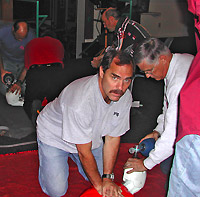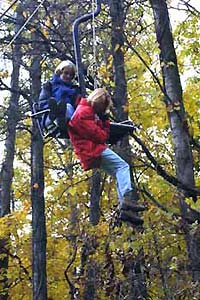
Becoming a Patroller
The candidate program begins each summer (mid-July) with Outdoor Emergency Care (OEC) classes and ends in mid February with an on-the-hill evaluation. The deadline for application each year is June 1.
Candidates attain National Ski Patrol Basic status by successfully completing the following:
Outdoor Emergency Care
In this 64-hour class, comparable to emergency medical technician (EMT) basic training, candidates develop skills necessary to handle injuries and medical emergencies. The class meets for four hours one evening a week for 16 weeks. Start date and weeknight for classes are set in June each year.
Students have weekly homework assignments and quizzes. A mid-term exam (similar to the final exam format) gives students feedback on course progress. The final exam consists of a written test and challenging scenarios, where students have to demonstrate their decision making and emergency care skills. Most students elect to meet one additional evening each week for a few hours to work on practical skills with instructors.
Successfully completing this course results in National Ski Patrol registration as an Auxiliary Patroller (qualified to administer emergency care). The text book used for the course may be purchased ahead of time: Outdoor Emergency Care (5th edition). This textbook is not a stand-alone source but is used to provide background information and supplement hands-on practical training sessions organized by OEC instructors.
 Cardio-Pulmonary Resuscitation (CPR)
Cardio-Pulmonary Resuscitation (CPR)
and Automatic External Defibrillator (AED)
Each candidate is nust enroll in, attend, and successfully complete a CPR for the professional rescuer class which includes AED. The American Red Cross (ARC) and American Heart Association (AHA) offer this 8-hour class year round. (There are a variety of other classes that do not meet National Ski Patrol requirements.) The course must be completed between May and mid October each year. To more evenly distribute study workloads, candidates are highly encouraged to attend May or June classes.
On-the-Hill Training
This class meets one evening per week (6-10 p.m.) for 12 weeks. It starts in late November or early December (dependent on resort opening date) and ends with a two-hour proficiency evaluation in mid to late February.
Here candidates are introduced to the Devil's Head Ski Patrol (DHSP) candidate training manual and DHSP Policy and Procedures. Training emphasis is on skiing skills and maneuvers and toboggan handling skills. Final evaluation prerequisites include regular weekly shift attendance, regular attendance at training classes and a recommendation from the on-the-hill trainer and candidate coordinator. Most students elect to meet for additional training periods with and without instructors as necessary to develop ski and toboggan handling skills.
 Chair Lift Evacuation Training
Chair Lift Evacuation Training
Class length is about 4 hours. Candidates are trained to follow DHSP chair evacuation procedures by participating in three-person evacuation teams to perform actual evacuations at Devil's Head Resort. Training also includes participating as an evacuee— riding the chair lift and being evacuated by fellow patrollers. Candidates work with trainers in a special first-year class for initial chair evacuation training.
Additional DHSP Requirements
- Complete a brief interview with the patrol director and/or candidate coordinator.
- Attend the DHSP Annual OEC Refresher.
- Perform a regular weekly assigned shift in addition to weekly on-the-hill training classes. Candidates are under the direct supervision of the crew chief to learn patrol procedures such as incident report completion and activating and coordinating Med Flight helicopter evacuations. As auxiliary patrollers, candidates use newly acquired OEC skills with real patients.
- Purchase books and equipment (assuming candidate has all necessary clothing and ski equipment):
- Textbook, Outdoor Emergency Care (5th edition) - July.
- First aid belt and contents - October
- Patrol jacket or vest - November
- The Ski Patrolers Manual - November
- Pay annual registration fee
Approximate total costs, including CPR course: $470.00
Other Information
Joining Devil's Head Ski Patrol is challenging but rewarding. Training is serious but conducted in a friendly atmosphere by volunteer teachers and trainers who enjoy what they do. Success depends on attitude and willingness to spend a few hours studying and practicing skills in addition to classroom work.
New recruits discovering DHSP during the ski season may start participating immediately in the DHSP Ski With a Patroller program. With approval of the patrol director, who will notify the crew chief in advance, you shadow a patroller for a whole shift to learn more about Devil's Head Ski Patrol. You may patrol on a snowboard, telemark or alpine skis. However, you must be trained and certified on the equipment you will use when patrolling.
There are a limited number of positions available for junior patrollers. They must be 15 years old by the date that the resort opens for the winter season. Junior patrollers must display a very high level of maturity and must complete and pass all courses. Junior patrollers receive a very high level supervision by crew chiefs.